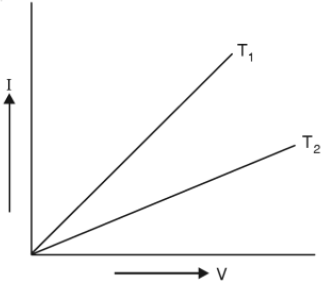Answer: (iii) 9 times
61. What voltage drop will be there across a 1 kW electric heater whose resistance when hot is 40 Ω ?
(i) 109 V
(ii) 50 V
(iii) 150 V
(iv) 200 V
Answer: (iv) 200 V
62. A resistor R1 dissipates the power P when connected to a certain generator. If resistance R2 is put in series with R1, the power dissipated by R1
(i) decreases
(ii) increases
(iii) remains the same
(iv) any of the above depending upon the values of R1 and R2
Answer: (i) decreases
63. In case of liquids, ohm’s law is
(i) fully obeyed
(ii) partially obeyed
(iii) there is no relation between current and p.d.
(iv) none of the above
Answer: (i) fully obeyed
64. Two electric bulbs rated for the same voltage have powers of 200 W and 100 W. If their resistances are respectively R1 and R2, then,
(i) R1 = 2R2
(ii) R2 = 2R1
(iii) R2 = 4 R1
Answer: (ii) R2 = 2R1
65. A copper wire has a resistance of 10 Ω. It is stretched by one-tenth of its original length. Then its resistance will be
(i) 10 Ω
(ii) 12.1 Ω
(iii) 9 Ω
(iv) 11 Ω
Answer: (ii) 12.1 Ω

66. The current-voltage graphs for a given metallic wire at two different temperatures T1, and T2 are shown in Fig. 3. Then
(i) T2 > T1
(ii) T2 < T1
(iii) T1 = T2
(iv) none of the above
Answer: (i) T2 > T1
67. 1020 electrons each having a charge of 1.6 x 10-19C pass from a point X to a point Y in 0.1 s. The current Flowing is
(i) 16A
(ii) 1.6 A
(iii) 160 A
(iv) 1 A
Answer: (iii) 160 A
68. No current flows between two charged bodies if they have same
(i) capacity
(ii) potential
(iii) charge
(iv) none of the above
Answer: (ii) potential
69. A carbon electrode has a resistance of 0.125 Ω at 20°C. The temperature coefficient of carbon is -0.0005 at 20°C. What will be the resistance of electrode at 85°C ?
(i) 4 Ω
(ii) 0.5 Ω
(iii) 1.2 Ω
(iv) 0.121 Ω
Answer: (iv) 0.121 Ω
70. The specific resistance of a wire 1.1 m long, 0.4 mm diameter having a resistance of 4.2 Ω will be
(i) 48 x 10-8 Ωm
(ii) 40 x 108 Ωm
(iii) 4 x 10-6 Ωm
(iv) none of the above
Answer: (i) 48 x 10-8 Ωm
71. Which of the following is the best material for making connecting wires ?
(i) manganin
(ii) constantan
(iii) copper
(iv) nichrome
Answer: (iii) copper
72. The specific resistance of the material of wire depends on
(i) the area of cross-section
(ii) length
(iii) mass
(iv) none of the above
Answer: (iv) none of the above
73. Ampere – second is the unit of
(i) power
(ii) energy
(iii) e.m.f.
(iv) charge
Answer: (iv) charge
75. What will be the resistance value corresponding to colour code yellow, violet, orange, silver ?
(i) 47 kΩ ± 10%
(ii) 4.7 kΩ ± 20 %
(iii) 2 kΩ ± 10%
(iv) none of the above
Answer: (i) 47 kΩ ± 10%
76. What will be the resistance value corresponding to colour code brown, black, red ?
(i) 2 kΩ ± 10%
(ii) 1 kΩ ± 20 %
(iii) 7 kΩ ± 20 %
(iv) none of the above
Answer: (ii) 1 kΩ ± 20 %
77. Two resistors A and B have resistances RA and RB respectively with RA < RB. The resistivities of their materials are ρA and ρB. Then
(i) ρA > ρB
(ii) ρA = ρB
(iii) ρA < ρB
(iv) Information insufficient
Answer: (iv) Information insufficient
78. As the temperature of a metallic resistor is increased, the product of its resistivity and conductivity
(i) increases
(ii) decreases
(iii) remains constant
(iv) may increase or decrease
Answer: (iii) remains constant
79. A resistor develops 400 J of thermal energy in 10 s when a current of 2 A is passed through it. The resistance of the resistor is
(i) 10 Ω
(ii) 20 Ω
(iii) 5 Ω
(iv) 40 Ω
Answer: (i) 10 Ω
80. An electron moves in a circle of radius 10 cm with a constant speed of 4 x 106 ms-1. The electric current at a point on the circle is
(i) 1 x 10-12A
(ii) 4 x 10-7A
(iii) 2 x 10-6A
(iv) none of above
Answer: (i) 1 x 10-12A
81. The resistance of human body is about
(i) 200 Ω
(ii) 10 Ω
(iii) 1000 Ω
(iv) 25 Ω
Answer: (iii) 1000 Ω
83. The hot resistance of electric bulb’s filament is higher than its cold resistance because the temperature co-efficient of filament is
(i) zero
(ii) positive
(iii) negative
(iv) none of above
Answer: (ii) positive
84. A nichrome wire used as a heater coil has a resistance of 2 Ω/m. For a heater of 1 kW at 200 V, the length of the wire required is
(i) 80m
(ii) 40m
(iii) 20m
(iv) 24m
Answer: (iii) 20m
85. When 1 V is applied in a circuit a current of 1 µA flows through it. The conductance of the circuit is
(i) 1 µ mho
(ii) 106 mho
(iii) 2 µ mho
(iv) none of above
Answer: (i) 1 µ mho
Thanks for reading about “electrical test questions and answers”.